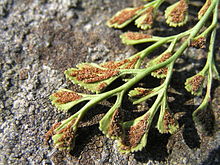This article needs additional citations for
verification. (June 2016) |
| Wall rue | |
|---|---|

| |
|
Scientific classification
| |
| Kingdom: | Plantae |
| Clade: | Tracheophytes |
| Division: | Polypodiophyta |
| Class: | Polypodiopsida |
| Order: | Polypodiales |
| Suborder: | Aspleniineae |
| Family: | Aspleniaceae |
| Genus: | Asplenium |
| Species: | A. ruta-muraria
|
| Binomial name | |
| Asplenium ruta-muraria | |
Asplenium ruta-muraria is a species of fern commonly known as wall-rue [1] (but which, as a fern, is not by any means closely related to common rue). It is a very small epipetric species, growing exclusively on limestone and other calcareous rocks. Its fronds are bluish-green and are heavily sub-divided, becoming up to 12 cm in length.

Taxonomy
Linnaeus first gave wall-rue the binomial Asplenium ruta-muraria in his Species Plantarum of 1753. [2]
A global phylogeny of Asplenium published in 2020 divided the genus into eleven clades, [3] which were given informal names pending further taxonomic study. A. ruta-muraria belongs to the "Pleurosorus subclade" of the "Pleurosorus clade". [4] The Pleurosorus clade has a worldwide distribution; members are generally small and occur on hillsides, often sheltering among rocks in exposed habitats. A. ruta-muraria is exceptional within the subclade for its lack of hairs on the leaf. The phylogeny suggests that multiple cryptic species may be present among plants now called A. ruta-muraria. [5] Within the subclade, the A. ruta-muraria aggregate (including A. dolomiticum) is sister to the species formerly segregated in the genus Pleurosorus. [4]
Distribution and habitat
Asplenium ruta-muraria is native to Europe, East Asia, and eastern North America. [6] In North America, its range extends from western New England southwest along the Appalachian Mountains to Alabama and Tennessee. It is also found in the Ozarks and in southern Indiana and Ohio, with outlying occurrences in Michigan, Ontario, Quebec, and Clinton County, Iowa. [7]
In Europe, it commonly invades masonry and is a common species, while in the United States, it is more difficult to find, favouring pockets in very well-weathered and rather dry limestone outcrops.
Notes
- ^ English Names for Korean Native Plants (PDF). Pocheon: Korea National Arboretum. 2015. p. 365. ISBN 978-89-97450-98-5. Archived from the original (PDF) on 25 May 2017. Retrieved 25 January 2017 – via Korea Forest Service.
- ^ Linnaeus 1753, p. 1081.
- ^ Xu et al. 2020, p. 27.
- ^ a b Xu et al. 2020, p. 30.
- ^ Xu et al. 2020, p. 46.
- ^ Wagner, Moran & Werth 1993.
- ^ Kartesz 2014.
References
- Kartesz, John T. (2014). "Asplenium". Biota of North America Program.
- Linnaeus, C. (1753). Species Plantarum. Vol. II (1st ed.). Stockholm: Laurentii Salvii.
- Wagner, Warren H. Jr.; Moran, Robbin C.; Werth, Charles R. (1993). "Asplenium ruta-muraria". In Flora of North America Editorial Committee (ed.). Flora of North America North of Mexico. Vol. 2: Pteridophytes and Gymnosperms. New York and Oxford: Oxford University Press. Retrieved 2016-03-21.
- Xu, Ke-Wang; Zhang, Liang; Rothfels, Carl J.; Smith, Alan R.; Viane, Ronald; Lorence, David; Wood, Kenneth R.; Cheng, Cheng-Wei; Knapp, Ralf; Zhou, Lin; Lu, Ngan Thi; Zhou, Xin-Mao; Wei, Hong-Jin; Fan, Qiang; Chen, Su-Fang; Cicuzza, Daniele; Gao, Xin-Fen; Li, Wen-Bo; Zhang, Li-Bing (2020). "A global plastid phylogeny of the fern genus Asplenium (Aspleniaceae)". Cladistics. 36 (1): 22–71. doi: 10.1111/cla.12384. PMID 34618950. S2CID 201197385.
Averis, Ben (2013). Plants and habitats. ISBN 978-0-9576081-0-8.
External links
-
 Media related to
Asplenium ruta-muraria at Wikimedia Commons
Media related to
Asplenium ruta-muraria at Wikimedia Commons -
 Data related to
Asplenium ruta-muraria at Wikispecies
Data related to
Asplenium ruta-muraria at Wikispecies
